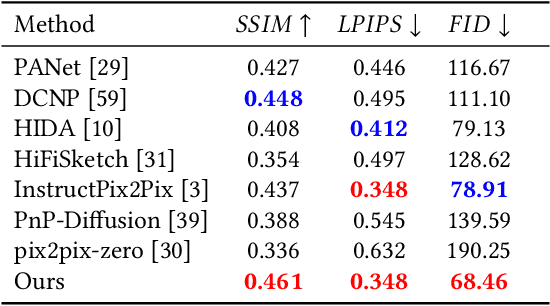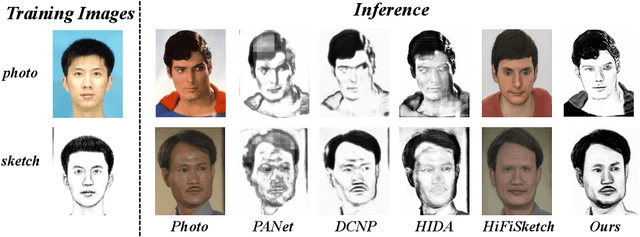Sen Zhang
One-shot Face Sketch Synthesis in the Wild via Generative Diffusion Prior and Instruction Tuning
Jun 18, 2025



Abstract:Face sketch synthesis is a technique aimed at converting face photos into sketches. Existing face sketch synthesis research mainly relies on training with numerous photo-sketch sample pairs from existing datasets. However, these large-scale discriminative learning methods will have to face problems such as data scarcity and high human labor costs. Once the training data becomes scarce, their generative performance significantly degrades. In this paper, we propose a one-shot face sketch synthesis method based on diffusion models. We optimize text instructions on a diffusion model using face photo-sketch image pairs. Then, the instructions derived through gradient-based optimization are used for inference. To simulate real-world scenarios more accurately and evaluate method effectiveness more comprehensively, we introduce a new benchmark named One-shot Face Sketch Dataset (OS-Sketch). The benchmark consists of 400 pairs of face photo-sketch images, including sketches with different styles and photos with different backgrounds, ages, sexes, expressions, illumination, etc. For a solid out-of-distribution evaluation, we select only one pair of images for training at each time, with the rest used for inference. Extensive experiments demonstrate that the proposed method can convert various photos into realistic and highly consistent sketches in a one-shot context. Compared to other methods, our approach offers greater convenience and broader applicability. The dataset will be available at: https://github.com/HanWu3125/OS-Sketch
Regularized Adaptive Graph Learning for Large-Scale Traffic Forecasting
Jun 08, 2025Abstract:Traffic prediction is a critical task in spatial-temporal forecasting with broad applications in travel planning and urban management. Adaptive graph convolution networks have emerged as mainstream solutions due to their ability to learn node embeddings in a data-driven manner and capture complex latent dependencies. However, existing adaptive graph learning methods for traffic forecasting often either ignore the regularization of node embeddings, which account for a significant proportion of model parameters, or face scalability issues from expensive graph convolution operations. To address these challenges, we propose a Regularized Adaptive Graph Learning (RAGL) model. First, we introduce a regularized adaptive graph learning framework that synergizes Stochastic Shared Embedding (SSE) and adaptive graph convolution via a residual difference mechanism, achieving both embedding regularization and noise suppression. Second, to ensure scalability on large road networks, we develop the Efficient Cosine Operator (ECO), which performs graph convolution based on the cosine similarity of regularized embeddings with linear time complexity. Extensive experiments on four large-scale real-world traffic datasets show that RAGL consistently outperforms state-of-the-art methods in terms of prediction accuracy and exhibits competitive computational efficiency.
Neuron-level Balance between Stability and Plasticity in Deep Reinforcement Learning
Apr 09, 2025Abstract:In contrast to the human ability to continuously acquire knowledge, agents struggle with the stability-plasticity dilemma in deep reinforcement learning (DRL), which refers to the trade-off between retaining existing skills (stability) and learning new knowledge (plasticity). Current methods focus on balancing these two aspects at the network level, lacking sufficient differentiation and fine-grained control of individual neurons. To overcome this limitation, we propose Neuron-level Balance between Stability and Plasticity (NBSP) method, by taking inspiration from the observation that specific neurons are strongly relevant to task-relevant skills. Specifically, NBSP first (1) defines and identifies RL skill neurons that are crucial for knowledge retention through a goal-oriented method, and then (2) introduces a framework by employing gradient masking and experience replay techniques targeting these neurons to preserve the encoded existing skills while enabling adaptation to new tasks. Numerous experimental results on the Meta-World and Atari benchmarks demonstrate that NBSP significantly outperforms existing approaches in balancing stability and plasticity.
AdvSGM: Differentially Private Graph Learning via Adversarial Skip-gram Model
Mar 27, 2025Abstract:The skip-gram model (SGM), which employs a neural network to generate node vectors, serves as the basis for numerous popular graph embedding techniques. However, since the training datasets contain sensitive linkage information, the parameters of a released SGM may encode private information and pose significant privacy risks. Differential privacy (DP) is a rigorous standard for protecting individual privacy in data analysis. Nevertheless, when applying differential privacy to skip-gram in graphs, it becomes highly challenging due to the complex link relationships, which potentially result in high sensitivity and necessitate substantial noise injection. To tackle this challenge, we present AdvSGM, a differentially private skip-gram for graphs via adversarial training. Our core idea is to leverage adversarial training to privatize skip-gram while improving its utility. Towards this end, we develop a novel adversarial training module by devising two optimizable noise terms that correspond to the parameters of a skip-gram. By fine-tuning the weights between modules within AdvSGM, we can achieve differentially private gradient updates without additional noise injection. Extensive experimental results on six real-world graph datasets show that AdvSGM preserves high data utility across different downstream tasks.
GraphSparseNet: a Novel Method for Large Scale Trafffic Flow Prediction
Feb 27, 2025



Abstract:Traffic flow forecasting is a critical spatio-temporal data mining task with wide-ranging applications in intelligent route planning and dynamic traffic management. Recent advancements in deep learning, particularly through Graph Neural Networks (GNNs), have significantly enhanced the accuracy of these forecasts by capturing complex spatio-temporal dynamics. However, the scalability of GNNs remains a challenge due to their exponential growth in model complexity with increasing nodes in the graph. Existing methods to address this issue, including sparsification, decomposition, and kernel-based approaches, either do not fully resolve the complexity issue or risk compromising predictive accuracy. This paper introduces GraphSparseNet (GSNet), a novel framework designed to improve both the scalability and accuracy of GNN-based traffic forecasting models. GraphSparseNet is comprised of two core modules: the Feature Extractor and the Relational Compressor. These modules operate with linear time and space complexity, thereby reducing the overall computational complexity of the model to a linear scale. Our extensive experiments on multiple real-world datasets demonstrate that GraphSparseNet not only significantly reduces training time by 3.51x compared to state-of-the-art linear models but also maintains high predictive performance.
Cardiverse: Harnessing LLMs for Novel Card Game Prototyping
Feb 10, 2025Abstract:The prototyping of computer games, particularly card games, requires extensive human effort in creative ideation and gameplay evaluation. Recent advances in Large Language Models (LLMs) offer opportunities to automate and streamline these processes. However, it remains challenging for LLMs to design novel game mechanics beyond existing databases, generate consistent gameplay environments, and develop scalable gameplay AI for large-scale evaluations. This paper addresses these challenges by introducing a comprehensive automated card game prototyping framework. The approach highlights a graph-based indexing method for generating novel game designs, an LLM-driven system for consistent game code generation validated by gameplay records, and a gameplay AI constructing method that uses an ensemble of LLM-generated action-value functions optimized through self-play. These contributions aim to accelerate card game prototyping, reduce human labor, and lower barriers to entry for game developers.
Generative Adversarial Networks Bridging Art and Machine Intelligence
Feb 09, 2025



Abstract:Generative Adversarial Networks (GAN) have greatly influenced the development of computer vision and artificial intelligence in the past decade and also connected art and machine intelligence together. This book begins with a detailed introduction to the fundamental principles and historical development of GANs, contrasting them with traditional generative models and elucidating the core adversarial mechanisms through illustrative Python examples. The text systematically addresses the mathematical and theoretical underpinnings including probability theory, statistics, and game theory providing a solid framework for understanding the objectives, loss functions, and optimisation challenges inherent to GAN training. Subsequent chapters review classic variants such as Conditional GANs, DCGANs, InfoGAN, and LAPGAN before progressing to advanced training methodologies like Wasserstein GANs, GANs with gradient penalty, least squares GANs, and spectral normalisation techniques. The book further examines architectural enhancements and task-specific adaptations in generators and discriminators, showcasing practical implementations in high resolution image generation, artistic style transfer, video synthesis, text to image generation and other multimedia applications. The concluding sections offer insights into emerging research trends, including self-attention mechanisms, transformer-based generative models, and a comparative analysis with diffusion models, thus charting promising directions for future developments in both academic and applied settings.
The Energy Loss Phenomenon in RLHF: A New Perspective on Mitigating Reward Hacking
Jan 31, 2025



Abstract:This work identifies the Energy Loss Phenomenon in Reinforcement Learning from Human Feedback (RLHF) and its connection to reward hacking. Specifically, energy loss in the final layer of a Large Language Model (LLM) gradually increases during the RL process, with an excessive increase in energy loss characterizing reward hacking. Beyond empirical analysis, we further provide a theoretical foundation by proving that, under mild conditions, the increased energy loss reduces the upper bound of contextual relevance in LLMs, which is a critical aspect of reward hacking as the reduced contextual relevance typically indicates overfitting to reward model-favored patterns in RL. To address this issue, we propose an Energy loss-aware PPO algorithm (EPPO) which penalizes the increase in energy loss in the LLM's final layer during reward calculation to prevent excessive energy loss, thereby mitigating reward hacking. We theoretically show that EPPO can be conceptually interpreted as an entropy-regularized RL algorithm, which provides deeper insights into its effectiveness. Extensive experiments across various LLMs and tasks demonstrate the commonality of the energy loss phenomenon, as well as the effectiveness of \texttt{EPPO} in mitigating reward hacking and improving RLHF performance.
Structure-Preference Enabled Graph Embedding Generation under Differential Privacy
Jan 07, 2025



Abstract:Graph embedding generation techniques aim to learn low-dimensional vectors for each node in a graph and have recently gained increasing research attention. Publishing low-dimensional node vectors enables various graph analysis tasks, such as structural equivalence and link prediction. Yet, improper publication opens a backdoor to malicious attackers, who can infer sensitive information of individuals from the low-dimensional node vectors. Existing methods tackle this issue by developing deep graph learning models with differential privacy (DP). However, they often suffer from large noise injections and cannot provide structural preferences consistent with mining objectives. Recently, skip-gram based graph embedding generation techniques are widely used due to their ability to extract customizable structures. Based on skip-gram, we present SE-PrivGEmb, a structure-preference enabled graph embedding generation under DP. For arbitrary structure preferences, we design a unified noise tolerance mechanism via perturbing non-zero vectors. This mechanism mitigates utility degradation caused by high sensitivity. By carefully designing negative sampling probabilities in skip-gram, we theoretically demonstrate that skip-gram can preserve arbitrary proximities, which quantify structural features in graphs. Extensive experiments show that our method outperforms existing state-of-the-art methods under structural equivalence and link prediction tasks.
Deep Learning Model Security: Threats and Defenses
Dec 12, 2024
Abstract:Deep learning has transformed AI applications but faces critical security challenges, including adversarial attacks, data poisoning, model theft, and privacy leakage. This survey examines these vulnerabilities, detailing their mechanisms and impact on model integrity and confidentiality. Practical implementations, including adversarial examples, label flipping, and backdoor attacks, are explored alongside defenses such as adversarial training, differential privacy, and federated learning, highlighting their strengths and limitations. Advanced methods like contrastive and self-supervised learning are presented for enhancing robustness. The survey concludes with future directions, emphasizing automated defenses, zero-trust architectures, and the security challenges of large AI models. A balanced approach to performance and security is essential for developing reliable deep learning systems.
 Add to Chrome
Add to Chrome Add to Firefox
Add to Firefox Add to Edge
Add to Edge